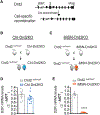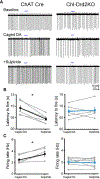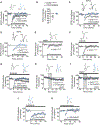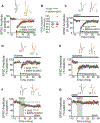Dual Dopaminergic Regulation of Corticostriatal Plasticity by Cholinergic Interneurons and Indirect Pathway Medium Spiny Neurons
- PMID: 30208314
- PMCID: PMC6182771
- DOI: 10.1016/j.celrep.2018.08.042
Dual Dopaminergic Regulation of Corticostriatal Plasticity by Cholinergic Interneurons and Indirect Pathway Medium Spiny Neurons
Abstract
Endocannabinoid (eCB)-mediated long-term depression (LTD) requires dopamine (DA) D2 receptors (D2Rs) for eCB mobilization. The cellular locus of the D2Rs involved in LTD induction remains highly debated. We directly examined the role in LTD induction of D2Rs expressed by striatal cholinergic interneurons (Chls) and indirect pathway medium spiny neurons (iMSNs) using neuron-specific targeted deletion of D2Rs. Deletion of Chl-D2Rs (Chl-Drd2KO) impaired LTD induction in both subtypes of MSNs. LTD induction was restored in the Chl-Drd2KO mice by an M1-selective muscarinic acetylcholine receptor antagonist. In contrast, after the deletion of iMSN-D2Rs (iMSN-Drd2KO), LTD induction was intact in MSNs. Separate interrogation of direct pathway and iMSNs revealed a deficit in LTD induction only at synapses onto iMSNs that lack D2Rs. LTD induction in iMSNs was restored by D2R agonist application. Our findings suggest that Chl D2Rs strongly modulate LTD induction in MSNs, with iMSN-D2Rs having a weaker, iMSN-specific, modulatory effect.
Keywords: D2 receptors; cholinergic interneurons; dMSNs; iMSNs; long-term depression.
Published by Elsevier Inc.
Conflict of interest statement
DECLARATION OF INTERESTS
The authors declare no competing interests.
Figures







Similar articles
-
Dopamine D2 receptor signaling on iMSNs is required for initiation and vigor of learned actions.Neuropsychopharmacology. 2020 Nov;45(12):2087-2097. doi: 10.1038/s41386-020-00799-1. Epub 2020 Aug 18. Neuropsychopharmacology. 2020. PMID: 32811899 Free PMC article.
-
Investigating the role of striatal dopamine receptor 2 in motor coordination and balance: Insights into the pathogenesis of DYT1 dystonia.Behav Brain Res. 2021 Apr 9;403:113137. doi: 10.1016/j.bbr.2021.113137. Epub 2021 Jan 18. Behav Brain Res. 2021. PMID: 33476687 Free PMC article.
-
Dopaminergic control of corticostriatal long-term synaptic depression in medium spiny neurons is mediated by cholinergic interneurons.Neuron. 2006 May 4;50(3):443-52. doi: 10.1016/j.neuron.2006.04.010. Neuron. 2006. PMID: 16675398
-
Striatal D2 receptors and LTD: yes, but not where you thought they were.Neuron. 2006 May 4;50(3):347-8. doi: 10.1016/j.neuron.2006.04.023. Neuron. 2006. PMID: 16675388 Review.
-
D1 and D2 dopamine-receptor modulation of striatal glutamatergic signaling in striatal medium spiny neurons.Trends Neurosci. 2007 May;30(5):228-35. doi: 10.1016/j.tins.2007.03.008. Epub 2007 Apr 3. Trends Neurosci. 2007. PMID: 17408758 Review.
Cited by
-
Dopamine D2 receptors in nucleus accumbens cholinergic interneurons increase impulsive choice.bioRxiv [Preprint]. 2023 Jan 20:2023.01.20.524596. doi: 10.1101/2023.01.20.524596. bioRxiv. 2023. Update in: Neuropsychopharmacology. 2023 Aug;48(9):1309-1317. doi: 10.1038/s41386-023-01608-1. PMID: 36711450 Free PMC article. Updated. Preprint.
-
Emerging roles of striatal dopamine D2 receptors in motivated behaviour: Implications for psychiatric disorders.Basic Clin Pharmacol Toxicol. 2020 Jun;126 Suppl 6(Suppl 6):47-55. doi: 10.1111/bcpt.13271. Epub 2019 Jun 28. Basic Clin Pharmacol Toxicol. 2020. PMID: 31188541 Free PMC article. Review.
-
Disentangling the diverse roles of dopamine D2 receptors in striatal function and behavior.Neurochem Int. 2019 May;125:35-46. doi: 10.1016/j.neuint.2019.01.022. Epub 2019 Feb 1. Neurochem Int. 2019. PMID: 30716356 Free PMC article. Review.
-
How changes in dopamine D2 receptor levels alter striatal circuit function and motivation.Mol Psychiatry. 2022 Jan;27(1):436-444. doi: 10.1038/s41380-021-01253-4. Epub 2021 Aug 12. Mol Psychiatry. 2022. PMID: 34385603 Free PMC article. Review.
-
Spiny Projection Neuron Dynamics in Toxin and Transgenic Models of Parkinson's Disease.Front Neural Circuits. 2019 Mar 15;13:17. doi: 10.3389/fncir.2019.00017. eCollection 2019. Front Neural Circuits. 2019. PMID: 30930753 Free PMC article. Review.
References
-
- Albin RL, Young AB, and Penney JB (1989). The functional anatomy of basal ganglia disorders. Trends Neurosci 12, 366–375. - PubMed
-
- Aosaki T, Miura M, Suzuki T, Nishimura K, and Masuda M (2010). Acetylcholine-dopamine balance hypothesis in the striatum: an update. Geriatr. Gerontol. Int 10 (Suppl 1), S148–S157. - PubMed
Publication types
MeSH terms
Substances
Grants and funding
LinkOut - more resources
Full Text Sources
Other Literature Sources
Molecular Biology Databases

